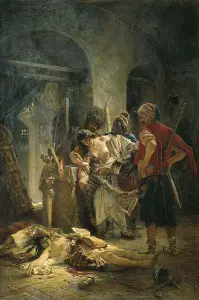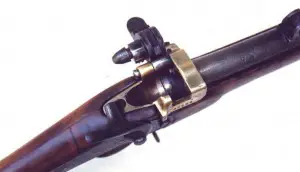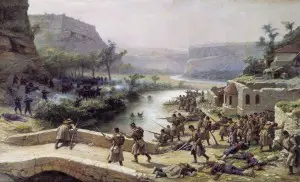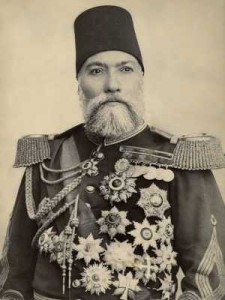
The Bulgarian Martyresses: Makovsky’s painting of bashi-bazouk misconduct was pan-Slavic war propaganda.
In 1877, Turkey and Russia were two empires experiencing the latest of many wars around their peripheries. The issues were the usual: territory and religion. You could as easily have said that it was one two-century war punctuated by tense armistices; for the nations had fought on and off since 1676.
The initial casus belli was a series of Ottoman atrocities committed by irregulars called the bashi-bazouks against Christian civilians in Bulgaria. Tsar Alexander II declared war, having secured the neutrality of the other European powers. The Russians marched into Romania (then an Ottoman province) to the applause of the Romanians. The Russians had a larger army and better organization. The Turks, though, had more modern weapons, thanks to a well-timed international buying spree. And when the Turks found themselves besieged in Plevna, the weapons made the difference — particularly the rifles, although the Turks also had modern Krupp artillery.
1878 was a time when the armaments of the world’s armies were in a transitional state. Smoothbore muskets had yielded by midcentury to the muzzleloading rifled muskets that worked such deadly execution in the US Civil War. But by war’s end, the coming thing was the round of fixed ammunition, which would enable repeating and automatic weapons…. someday. But this day, in 1878, those weapons were in their infancy. Most armies, including the US and British forces, were issuing weapons that were muzzleloaders modified to fire single rounds of fixed ammunition. The US weapon was the 1873 Springfield “trapdoor” rifle, and the British equivalent was the .577 Snyder.

1857/67 Krnka, from militaryrifles.com. Lots more photos of this (and all the other rifles mentioned in this post) over there.
The main rifle of the Russian Army — for that horde of 300,000 men was not armed in strict uniformity — was the 1867 Krnka. It was a conversion of the “6-line” (.60 caliber) muzzle-loader; the Krnka had a brass or bronze breech with a steel bolt that hinged up and to the left in Snyder fashion. In addition, some Russian troops had two rifles designed by the American ordnance officer Hiram Berdan; one (the 1868) had a hinged bolt like a Trapdoor Springfield, and the later 1870 model was a single-shot bolt-action rifle. The 1870 Berdan was the fastest-firing of these, but its 10.6 x 58mm blackpowder cartridge (about .43 caliber) wasn’t terribly accurate. Basically, none of these weapons provided an improvement in accuracy over the Civil-War era rifles they replaced, just a quantum improvement in rate of fire.
So when thousands of single-shot-armed Russians swarmed around the Bulgarian fortress city of Plevna, they expected the similar number of Turks inside the city to be roughly similarly armed. But Osman Pasha, the Turkish commander, had a trick up his embroidered sleeves: each Turk in the defensive works had two rifles. The Encyclopedia Britannica wrote:
In the matter of armament the Turks had the advantage. The artillery were armed with a Krupp breech-loading gun, which was better , than the Russian bronze gun, while the Peabody- Martini rifles of the infantry were superior to the Russian Krenk. The firearm of the Turkish, cavalry was the Winchester repeating carbine, which was inferior to the short Berden with which the Russian cavalry was armed. But this advantage in armament was discounted by the fact that, from motives of economy, the Turkish soldier had done but little rifle practice.
So as the Russians charged the fortress, shouting and firing, and awkwardly reloading thieir Krnkas or Berdans. Meanwhile, the Turks lay in wait, each with a British Peabody-Martini, capable of great long-range accuracy, and a loaded Winchester 1866, capable of rapid fire. When the Russians came into Martini range, the Turks began to pick them off, until they’d closed to within the 150 to 100 yard range of the brass-framed .44 rimfire Winchester. There at practically point-blank range the Russians ran into an unprecedented buzzsaw of rapid fire. The survivors retreated in disorder.
They organized, and attacked again, and were thrown back again. And so it went, Osman Pasha buying time for his nation to mobilize as the Russians crashed against his fortress. But the Russians cut off every source of resupply for him, and in time, the Turks no longer had the means to resist. Making a daring night sally, they threw up bridges and tried to get away — only to be intercepted and thrown back into the fortress.
Osman Pasha assessed the situation. He had no more means of resistance. With some trepidation, for auxiliaries and irregulars on both sides had visited terrible brutalities on prisoners and other noncombatants, he struck the Ottoman flag and surrendered. The Russian general treated him with respect. (For more on the defense of Plevna, read The Plevna Delay at militaryrifles.com).
In holding Plevna much longer that considered possible, by dragging out defeat and making the enemy pay and pay for it, Osman Pasha and his two-gun Turks had won an unexpected victory. In a just world, that might have won them the war. But in this world, the inept Ottoman Empire squandered the win; the Russians, buoyed by fresh Bulgarian and Serbian troops, ultimately advanced almost to Constantinople, and the Turks accepted a peace that cost them Serbia, Montenegro, Romania, and Bulgaria.

Russian Winchester 95 from 1915-17. This one is for sale by collectiblefirearms.com on their site and gunbroker.
Someone in Russia had a long memory, though. In World War I, when the Tsar’s armies were desperate for rifles, they contracted American and Swiss manufacturers to build their Mosin-Nagant rifles. But they also ordered 300,000 lever-action Winchester 95 rifles, and issued the 299,000 that came before the Revolution to frontline units.
This entry was posted in Foreign and Enemy Weapons, Rifles and Carbines, Weapons that Made their Mark on .

Kevin was a former Special Forces weapons man (MOS 18B, before the 18 series, 11B with Skill Qualification Indicator of S). His focus was on weapons: their history, effects and employment. He started WeaponsMan.com in 2011 and operated it until he passed away in 2017. His work is being preserved here at the request of his family.


